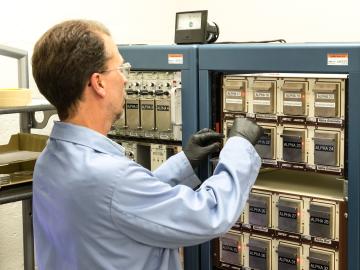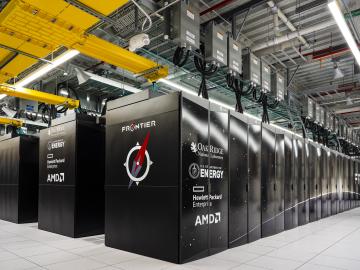
Filter News
Area of Research
News Type
News Topics
- (-) Advanced Reactors (2)
- (-) Biomedical (5)
- (-) Frontier (17)
- (-) Materials (54)
- (-) Microscopy (7)
- (-) Molten Salt (1)
- (-) Quantum Science (9)
- 3-D Printing/Advanced Manufacturing (19)
- Artificial Intelligence (25)
- Big Data (9)
- Bioenergy (22)
- Biology (29)
- Biotechnology (6)
- Buildings (13)
- Chemical Sciences (22)
- Clean Water (5)
- Composites (5)
- Computer Science (22)
- Coronavirus (4)
- Critical Materials (5)
- Cybersecurity (9)
- Education (3)
- Emergency (1)
- Energy Storage (19)
- Environment (41)
- Exascale Computing (14)
- Fossil Energy (2)
- Fusion (9)
- Grid (16)
- High-Performance Computing (31)
- Hydropower (3)
- Irradiation (1)
- Isotopes (9)
- Machine Learning (14)
- Materials Science (15)
- Mathematics (2)
- Mercury (2)
- Microelectronics (2)
- Nanotechnology (7)
- National Security (19)
- Neutron Science (32)
- Nuclear Energy (19)
- Partnerships (24)
- Physics (14)
- Polymers (4)
- Quantum Computing (12)
- Security (3)
- Simulation (28)
- Software (1)
- Space Exploration (4)
- Summit (9)
- Transportation (17)
Media Contacts

The International Standards Organization has put its stamp of approval on 18 nuclear analytical chemistry methods at ORNL. These testing and calibration methods have received ISO 17025 accreditation.

With the world’s first exascale supercomputer now fully open for scientific business, researchers can thank the early users who helped get the machine up to speed.

Researchers at the Department of Energy’s Oak Ridge National Laboratory were the first to use neutron reflectometry to peer inside a working solid-state battery and monitor its electrochemistry.

Creating energy the way the sun and stars do — through nuclear fusion — is one of the grand challenges facing science and technology. What’s easy for the sun and its billions of relatives turns out to be particularly difficult on Earth.

Scientist-inventors from ORNL will present seven new technologies during the Technology Innovation Showcase on Friday, July 14, from 8 a.m.–4 p.m. at the Joint Institute for Computational Sciences on ORNL’s campus.

An advance in a topological insulator material — whose interior behaves like an electrical insulator but whose surface behaves like a conductor — could revolutionize the fields of next-generation electronics and quantum computing, according to scientists at ORNL.

To support the development of a revolutionary new open fan engine architecture for the future of flight, GE Aerospace has run simulations using the world’s fastest supercomputer capable of crunching data in excess of exascale speed, or more than a quintillion calculations per second.

Innovations in artificial intelligence are rapidly shaping our world, from virtual assistants and chatbots to self-driving cars and automated manufacturing.

For more than 100 years, Magotteaux has provided grinding materials and castings for the mining, cement and aggregates industries. The company, based in Belgium, began its international expansion in 1968. Its second international plant has been a critical part of the Pulaski, Tennessee, economy since 1972.

Scientists at ORNL have invented a coating that could dramatically reduce friction in common load-bearing systems with moving parts, from vehicle drive trains to wind


